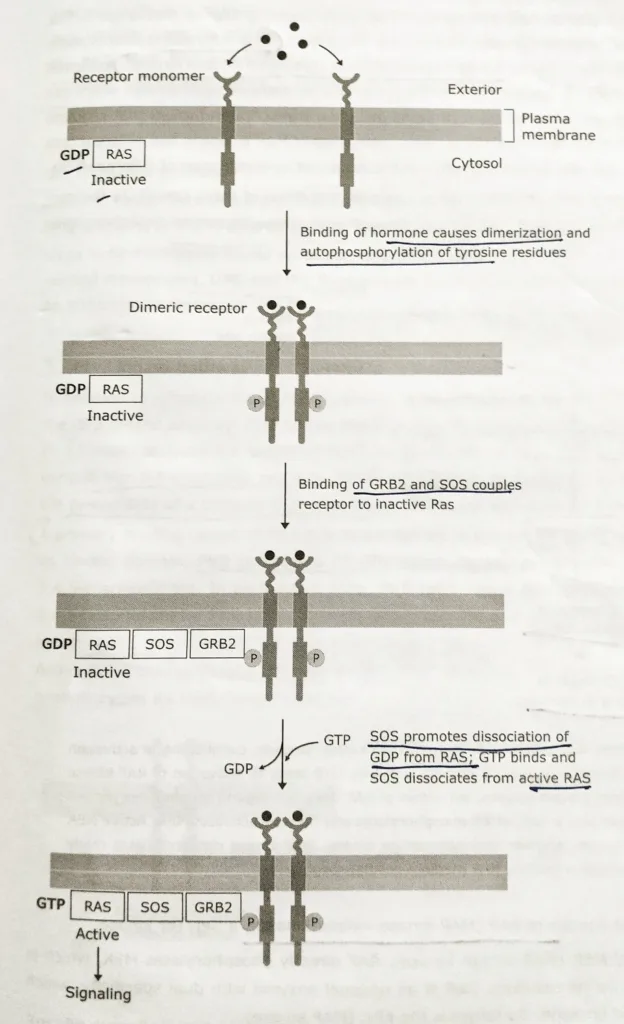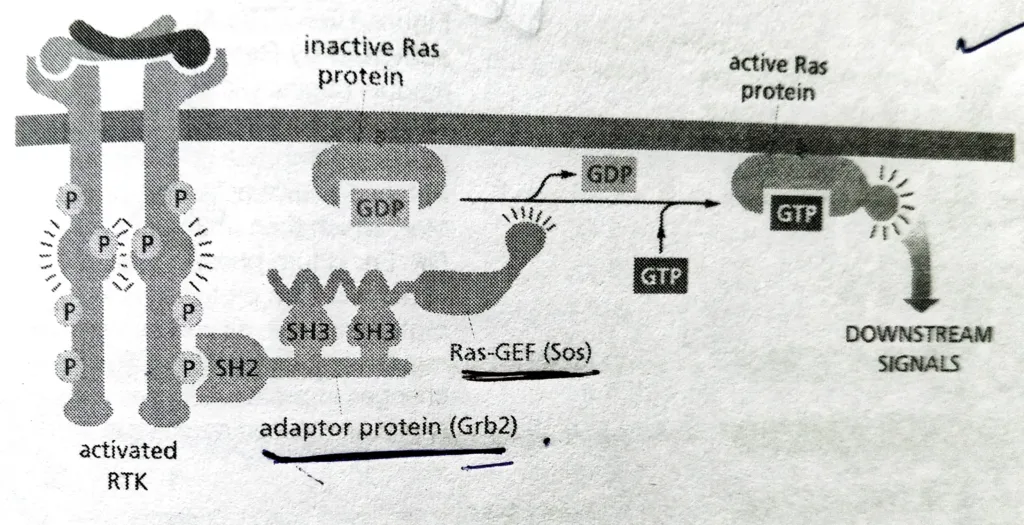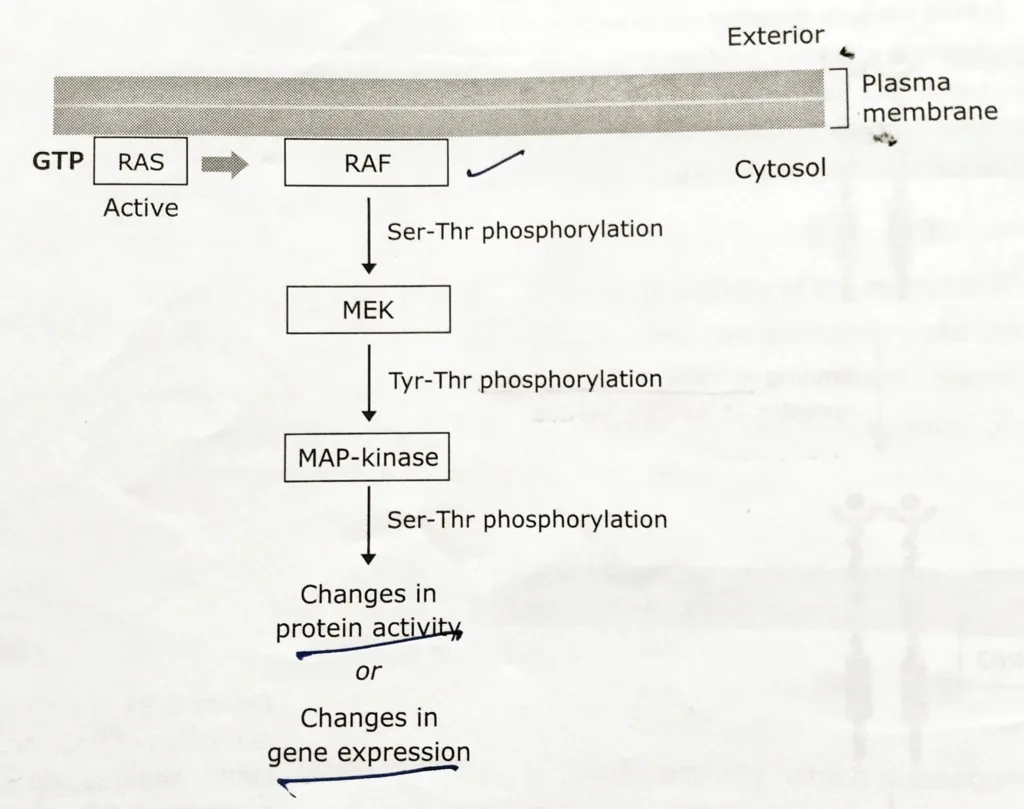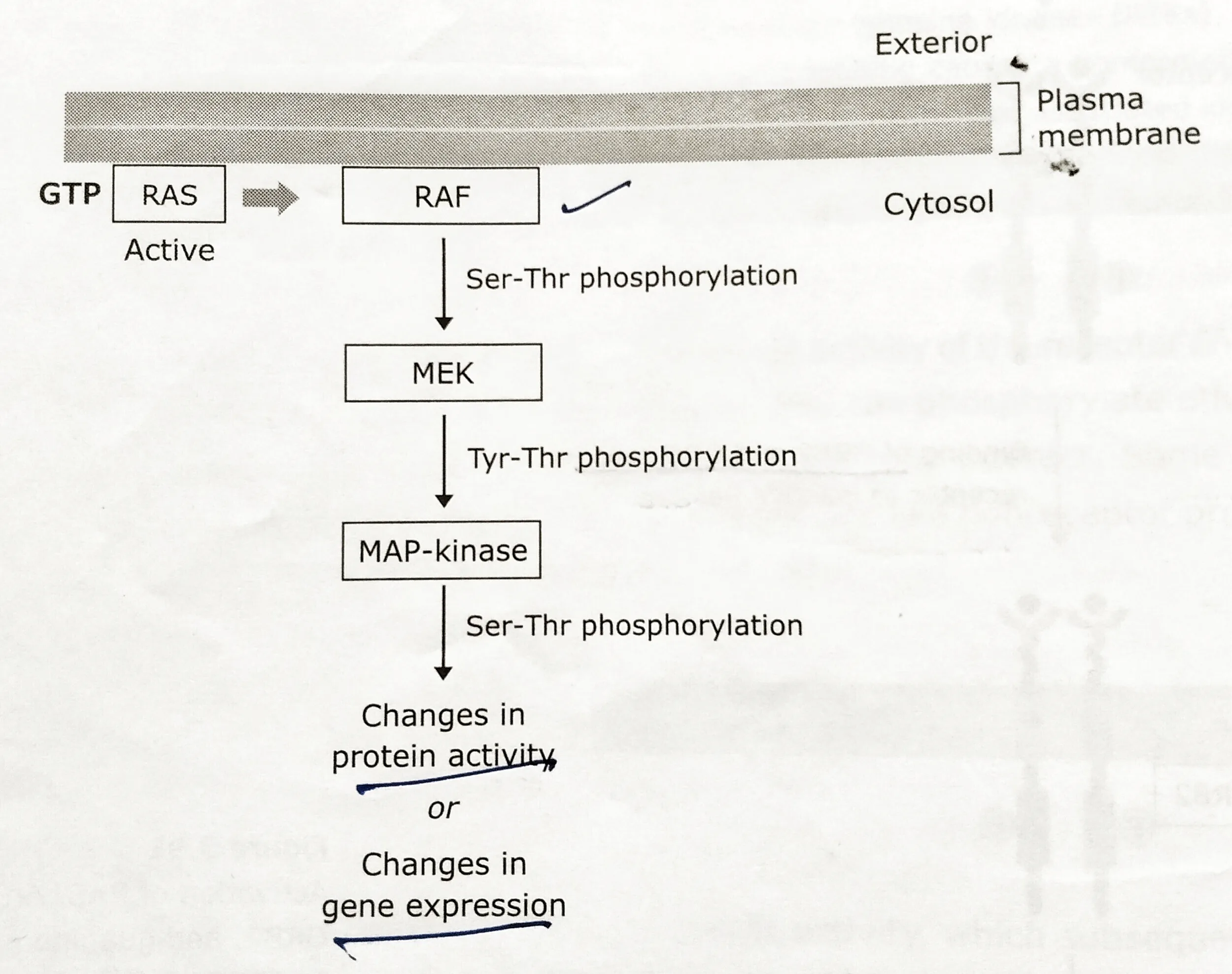Table of Contents
RAS MAP kinase pathway is one of the three major pathways that can transduce a signal from the activated, RTK (Receptor Tyrosine Kinase). Ligand-induced activation of an RTK stimulates its tyrosine kinase activity, which subsequently stimulates various signal-transduction pathways including the RAS-MAP kinase pathway.
RAS protein
RAS is an intracellular monomeric GTPase switch protein and functions in transducing signals from many different RTKs. There are three major, closely related Ras proteins in humans (H-, K-, and N-RAS). RAS is a lipid-linked (covalently attached lipid groups) protein present at the cytoplasmic face of the membrane.
RAS MAP kinase pathway – explanation
Ras cycles between an inactive GDP-bound form and active GTP-bound form. RAS cycling requires the assistance of two proteins, GEF (Guanine nucleotide exchange factor) and GAP (GTPase Activating protein). RAS activation is accelerated by a protein called GEF, which binds to the RAS-GDP complex, causing dissociation of the bound GTP. Because GTP is present in cells at a higher concentration than GDP, GTP binds spontaneously to empty RAS molecules, with the release of GEF.
The average lifetime of a GTP bound to RAS is about to 1 minute. GAP, which binds to RAS-GTP, accelerates its intrinsic GTPase activity. Binding of a ligand to an RTK leads to the activation of RAS. Two cytosolic proteins – adaptor protein and GEF provide the key links between RTK and RAS.
Adaptor proteins bind to an activated receptor, and then other proteins bind to them, and then therefore become substrate for the receptor. Adaptor has no catalytic activity of its own, but serves merely to bring other proteins to the receptor.
Adaptor protein in RAS MAP kinase pathway:
The cytosolic adaptor protein GRB2 binds to a specific phosphotyrosine on an activated, ligand-bound receptor and to the cytosolic GEF, SOS (Son of Sevenless) protein. SOS then promotes formation of active RAS-GTP. An Src Homology domain, SH2 domain, in GRB2 binds to a specific phosphotyrosine residue in the activated receptor.
The SH2 domain was originally identified as a conserved amino acid sequence in the non-catalytic region of tyrosine kinases encoded by viral oncogenes such as v-SRC. GRB2 also contains two SH3 domains, which bind to and activate SOS. SH3 binds to protein rich motifs.
The diagram shows the activation of RAS (RAS MAP kinase pathway)


MAP kinase pathways
RAS activates a downstream serine/ threonine phosphorylation cascade that includes a MAP -kinase (Mitogen Activated Protein Kinase).
Downstream serine/ threonine phosphorylation cascade follows the following patterns:
- Activated RAS binds to the N-terminal domain of RAF (MAP-kinase-kinase-kinase), ser/Thr kinase.
- RAF activity leads to the activation of MEK (MAP-kinase-kinase). RAF directly phosphorylates MEK, which is activated by phosphorylation on two serine residues. MEK is an unusual enzyme with dual specificity, which can phosphorylate both threonine and tyrosine. Its target is the ERK (MAP-kinase).
- MEK phosphorylates and activates MAP kinase. The MAP kinases are serine/ threonine kinases. After this point in the pathway, all the activating events take the form of serine/ threonine phosphorylation. MAP kinase phosphorylates many different proteins, including nuclear transcription factors, that mediate cellular responses.
Diagram of MAP kinase pathway:

Conclusion:
The ultimate effect of the MAP kinase pathway is a change in the transcription pattern. In the classic MAP kinase pathway, MAP kinase moves to the nucleus, where it phosphorylates target transcription factors.
In an alternative pathway, it phosphorylates a cytoplasmic factor, this may be a transcription factor that then moves to the nucleus or a protein that regulates a transcription factor.
Other related links:
- Cell cycle check points: https://thebiologyislove.com/cell-cycle-checkpoints/
- Nondisjunction and Aneuploidy: https://thebiologyislove.com/nondisjunction-and-aneuploidy/
Facebook link: https://www.facebook.com/share/p/pRMpKfLAmZ4gc51R/?mibextid=oFDknk
Instagram link: https://www.instagram.com/p/C7l2sAHRO3W/?igsh=em50aHJzd3B1eHU=

